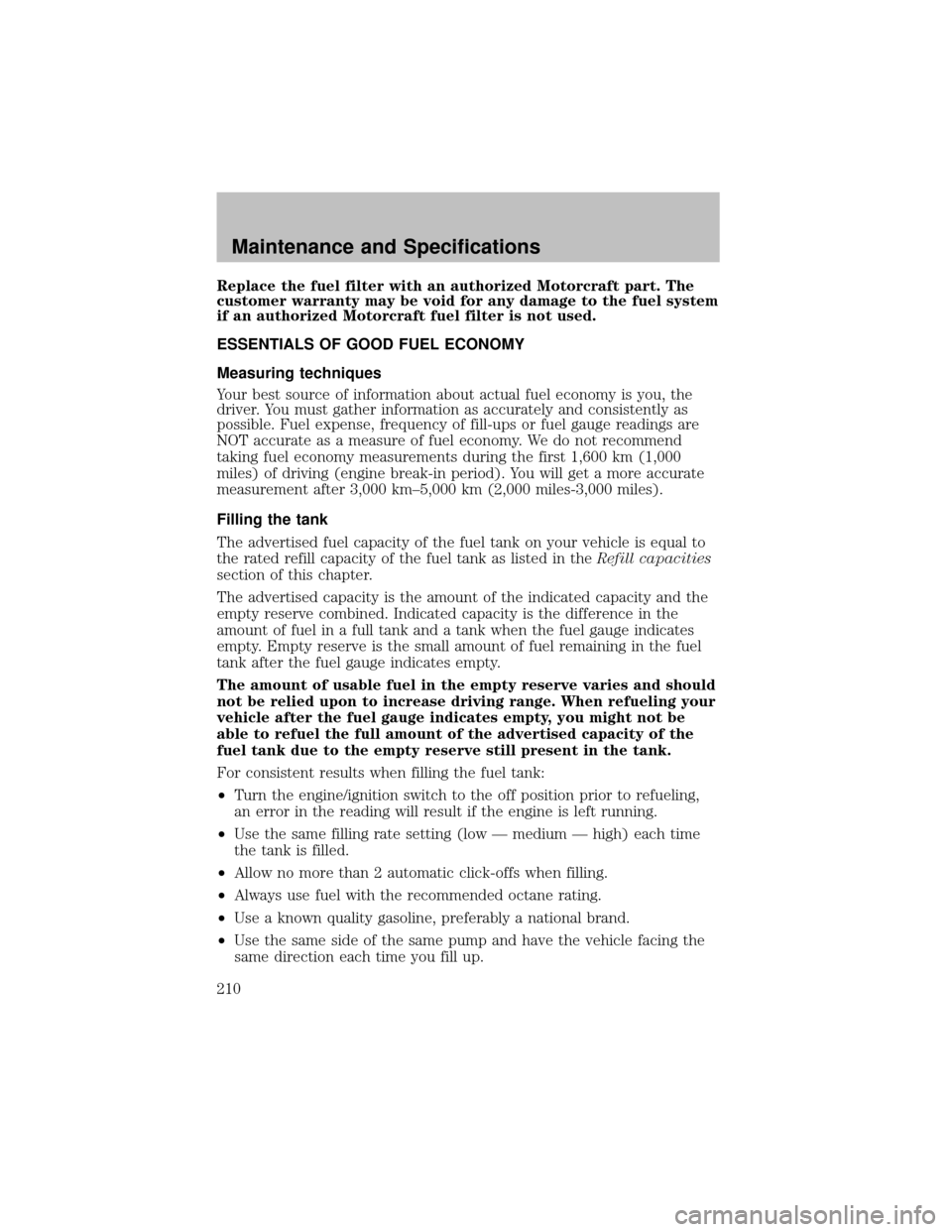Page 209 of 256

in the United States) because it maycause these problems to become
more pronounced. If the problems persist, see your dealer or a qualified
service technician.
It should not be necessaryto add anyaftermarket products to your fuel
tank if you continue to use high quality fuel of the recommended octane
rating. Aftermarket products could cause damage to the fuel system.
Repairs to correct the effects of using an aftermarket product in your
fuel maynot be covered byyour warranty.
Manyof the world’s automakers
issued the World-wide Fuel Charter
that recommends gasoline
specifications to provide improved
performance and emission control
system protection for your vehicle.
Gasolines that meet the World-wide
Fuel Charter should be used when
available. Ask your fuel supplier
about gasolines that meet the
World-wide Fuel Charter. In Canada,
look for fuels that displaytheAuto Makers’ Choice�logo.
Cleaner air
Ford endorses the use of reformulated “cleaner-burning” gasolines to
improve air quality.
Running out of fuel
Avoid running out of fuel because this situation mayhave an adverse
affect on powertrain components.
If you have run out of fuel:
•You mayneed to cycle the ignition from OFF to ON several times after
refueling, to allow the fuel system to pump the fuel from the tank to
the engine.
•Your “Service Engine Soon” indicator maycome on. For more
information on the “Service Engine Soon” indicator, refer to the
Instrument clusterchapter.
Fuel Filter
For fuel filter replacement, see your dealer or a qualified service
technician. Refer to the scheduled maintenance guide for the appropriate
intervals for changing the fuel filter.
Maintenance and Specifications
209
Page 210 of 256

Replace the fuel filter with an authorized Motorcraft part. The
customer warranty may be void for any damage to the fuel system
if an authorized Motorcraft fuel filter is not used.
ESSENTIALS OF GOOD FUEL ECONOMY
Measuring techniques
Your best source of information about actual fuel economyis you, the
driver. You must gather information as accuratelyand consistentlyas
possible. Fuel expense, frequencyof fill-ups or fuel gauge readings are
NOT accurate as a measure of fuel economy. We do not recommend
taking fuel economymeasurements during the first 1,600 km (1,000
miles) of driving (engine break-in period). You will get a more accurate
measurement after 3,000 km–5,000 km (2,000 miles-3,000 miles).
Filling the tank
The advertised fuel capacityof the fuel tank on your vehicle is equal to
the rated refill capacityof the fuel tank as listed in theRefill capacities
section of this chapter.
The advertised capacityis the amount of the indicated capacityand the
emptyreserve combined. Indicated capacityis the difference in the
amount of fuel in a full tank and a tank when the fuel gauge indicates
empty. Empty reserve is the small amount of fuel remaining in the fuel
tank after the fuel gauge indicates empty.
The amount of usable fuel in the empty reserve varies and should
not be relied upon to increase driving range. When refueling your
vehicle after the fuel gauge indicates empty, you might not be
able to refuel the full amount of the advertised capacity of the
fuel tank due to the empty reserve still present in the tank.
For consistent results when filling the fuel tank:
•Turn the engine/ignition switch to the off position prior to refueling,
an error in the reading will result if the engine is left running.
•Use the same filling rate setting (low — medium — high) each time
the tank is filled.
•Allow no more than 2 automatic click-offs when filling.
•Always use fuel with the recommended octane rating.
•Use a known qualitygasoline, preferablya national brand.
•Use the same side of the same pump and have the vehicle facing the
same direction each time you fill up.
Maintenance and Specifications
210
Page 251 of 256

refill capacities ........................228
specifications ..................232, 235
Exhaust fumes ..........................102
F
Fail safe cooling ........................204
Fluid capacities .........................228
Foglamps .....................................36
Four-Wheel Drive vehicles .......113
driving off road .......................116
electronic shift ................115–116
indicator light .........................113
lever operated shift ................114
manual locking hubs ..............113
preparing to drive your
vehicle .....................................105
Fuel ............................................205
calculating fuel economy.......210
cap ...........................................207
capacity...................................228
choosing the right fuel ...........208
comparisons with EPA fuel
economyestimates .................213
detergent in fuel .....................209
filling your vehicle
with fuel ..................205, 207, 210
filter, specifications ........209, 228
fuel pump shut-off switch .....153
improving fuel economy........210
octane rating ...................208, 235
quality......................................208
running out of fuel .................209
safetyinformation relating to
automotive fuels .....................205
Fuses ..................................154–155
G
Garage door opener ....................46Gas cap (see Fuel cap) ............207
Gas mileage
(see Fuel economy) .................210
Gauges .........................................13
GAWR (Gross Axle Weight
Rating) .......................................125
calculating ...............................127
definition .................................125
driving with a heavyload ......125
location ....................................125
GVWR (Gross Vehicle Weight
Rating) .......................................125
calculating .......................125, 127
definition .................................125
driving with a heavyload ......125
location ....................................125
H
Headlamps ...................................35
aiming ........................................37
autolamp system .......................35
daytime running lights .............36
flash to pass ..............................37
high beam .................................36
replacing bulbs .........................39
turning on and off ....................35
Heating
heating and air
conditioning system ...........32–33
Hood ..........................................192
I
Ignition .................................98, 235
Infant seats (see Safetyseats) ..90
Inspection/maintenance (I/M)
testing ........................................214
Index
251